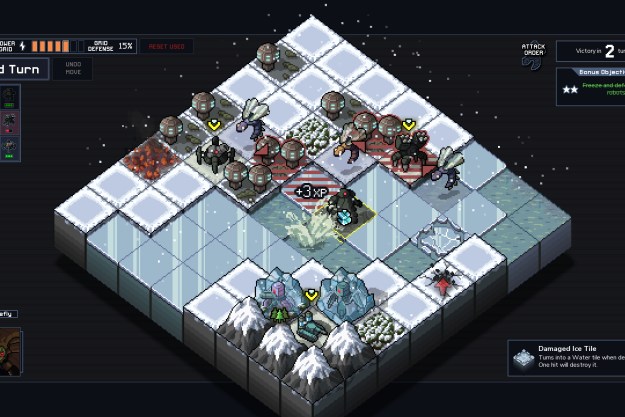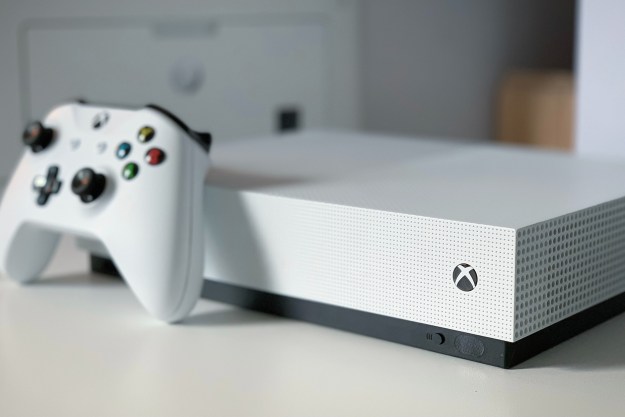
- Exquisitely tight, strategic gameplay
- Timeless, charming pixel aesthetic
- Near endless variety from relatively simple systems
- Tough, but fair challenge that scales well
- Prepare to lose. A lot.
In the future, humanity has fallen. We fought to the last, but monstrous insects — the Vek — rose up from beneath the ground and defeated our giant mech suits, overrunning what remained of civilization.
There’s still hope, though. We have enough energy to send one pilot back through a breach in time to mount up and try again. And again. And again.
Into the Breach is a tactical, turn-based strategy game where players control three-person squads of giant mechs to protect cities from monsters rising out of the depths. You may have heard this story before if you saw Pacific Rim, Guillermo del Toro’s ode to kaiju films.
Breach is the second game from developer Subset Games, and the long-awaited follow-up to the surprise indie hit FTL: Faster Than Light, a 2012 roguelike spaceship sim that set an early and unfairly high bar for Kickstarter-funded games.
While Into the Breach may bear some similarities to Nintendo’s Advance Wars series at a glance — it’s even available on the Nintendo Switch– Subset’s take on turn-based strategy has a wholly unique flavor. Into the Breach is a masterclass in elegant design, and one of the most focused and satisfying strategy games we’ve ever played.
You’re playing kaiju checkers, I’m playing kaiju chess
Every level in Into the Breach plays out on a tight, eight-by-eight grid spotted with mountains, forest, water, open space, and buildings. The Vek start tunneling up on one side of the map while your mechs start anywhere in a drop zone on the opposite end. At the start of each turn the Vek move around and indicate where they are going to attack, as well as where new ones will spring up at the end. You then have the turn to respond with each of your three mechs, in any order, who can move and then perform one attack (though not the other way around).
Into the Breach is a masterclass in elegant game design.
The goal in each level is to survive the allotted handful of turns until the Vek retreat, while preventing them from destroying the planet. You can complete any given level simply by outlasting them, but every time a building is destroyed, you lose one tick on the power grid meter at the top of the screen, which serves as an overall life meter for the run. Buildings have a low chance to resist damage, but generally one hit is all it takes to knock each one over, either from the Vek themselves, or from the collateral damage of tossing each other around like you’re in King of Monsters. With only five out of seven total power on the grid at the start, the stakes are very high from the get-go. A few mistakes will put you in dire straits.
At first blush you might think that, like in Advance Wars, strategy revolves around maneuvering your mechs to avoid damage while blasting down the enemy with superior firepower. The fact your first squad includes a biped mech that punches, a tank, and a mobile artillery cannon supports this notion. You’ll quickly realize, however, that you don’t put out nearly enough raw damage to wipe out everything in time. What makes Into the Breach so satisfying is that positioning matters just as much as — if not more than — directly hitting your opponents.
In addition to doing damage, most of your mechs’ attacks also push their targets around. Colliding with anything, whether a building, mountain, or another unit, does one damage to both parties. Unlike their aquatic forebears in Pacific Rim, Vek can’t stand the ocean, so any ground-bound Vek that get knocked into water or chasms are immediately destroyed. In addition to direct damage, you have to consider moving Vek around to use the environment, or even to redirect their own attacks at one another. It’s reminiscent of Aikido, where the best technique is often to turn your opponent’s own momentum against them.
Because of the breadth of potential solutions to any given round, Into the Breach continually presents you the chance to feel wonderfully clever. Using three mechs to turn away five far more powerful Vek is sure to put a smile on your face. The tight maps and interactions mean that nothing is wasted, and every turn is a fresh puzzle to solve.
Jägermeisters
The lifespan of that puzzle is dramatically extended by the variety contained within its systems. Completing achievements earns you coins, which are spent between games to unlock new squads of three mechs. Like the variant ships in FTL, every new squad features its own unique synergies, with three unique achievements to provide a little guidance on how you should use them.
The best technique is often to turn your enemy’s momentum against them.
The positional focus of the gameplay is even more apparent when you delve into the other squads, most of which feature at least one mech that focuses exclusively on moving units around instead of attacking them directly. Each of the eight squads has its own theme. There’s the Steel Judoka, a squad that focuses on manipulating the Vek against one another, or the Rusting Hulks, who gradually fill the battlefield with damaging storm clouds.
Crucially, none of these unlockable squads is more powerful than your starting mechs. They’re just more specialized and situational, demanding greater tactical imagination use properly.
You can also go in with custom or random squads comprising any mechs you’ve unlocked so far. With 24 mechs in all, and no restrictions on duplicates, that makes for 13,824 squads to try. They won’t all be viable, but finding the diamonds in the rough will be half the fun for some players.
The world you’re protecting is divided into four islands, each run by a different megacorporation with its own unique powers. The terraforming R.S.T. Corporation alters the landscape as you play, for example. When you clear all but three regions on each island, a boss fight will appear at the Corporate HQ.

After completing the islands once in sequence, you can tackle them in any order. Secure at least two and you can go on to the final battle, a two-phase fight on the volcanic island that the Vek call home. No matter the order of the islands or how many you complete, the challenge scales to match, giving you flexibility for short or long games as you prefer.
Each mission also has secondary objectives, such as protecting particular buildings, or blocking a certain number of Vek from emerging. Completing them nets you extra reactor cores for upgrading your mechs, power restored to the grid, new pilots with special abilities (one of which you can select at the start of the game from those you’ve found), or reputation points, which you can spend at after completing each island to buy from a randomized selection of new weapons, as well as more reactor cores and power.
Like the mechs, new weapons aren’t better — just different. Weapons like the artillery cannon, which damages two tiles and drives foes in opposite directions, sound great until you realize the Vek will be mixed up with your own mechs, and the buildings you’re trying to protect. Reactor Cores let you increase stats like damage or movement, or apply additional effects to your attacks, but they’re a precious resource, and you’ll never be able to get anywhere near fully upgrading your squad. You have to spend your resources wisely.
Nothing up my sleeves
Into the Breach has the design elegance of a classic board game like the Mensa-approved Hive, which is easy to teach, but has a profoundly high ceiling for mastery because of how its simple pieces combine to create unique and interesting board states every turn, even after years with the game. Breach reveals nearly all of itself in the first few hours of play: there are only a handful of basic Vek types, with “alpha” and boss variants, with no major final act twists or reveals. The drive to keep playing comes not from wanting to see new content, but rather to solve new and interesting configurations of the content you already know.
Subset Games has delivered one of the tightest strategy games we’ve ever seen.
The puzzle is, in part, so deliciously crunchy because of how small all of the numbers are. No quantity that you’ll ever need to think about in the game is ever higher than 10, and figures are often quite a bit lower. You can count on a single hand the damage your dealing, the life points you have remaining, and the number of opponents on the battlefield at any given time. Keeping everything small plays masterfully into the notion that people can only hold seven digits (plus or minus two) in their head at any given time. It’s challenging without overtaxing the player’s cognitive load.
It also makes the difficulty razor-sharp. Easy mode just slightly reduces the Vek spawn rate — generally just one fewer per round — but that makes a world of difference for the overall challenge. Hard, meanwhile, adds just a few more Vek and more frequent alpha variants. Point total is scaled in difficulty, but fortunately most of the achievements don’t care about it, allowing you to unlock new squads on easy without needing to be a master pilot.
Our Take
Subset Games has delivered one of the tightest strategy games we’ve ever seen. It reminds us in that regard of Inside, another small and perfectly-honed indie game that developer Playdead spent five years developing after a beloved debut title. Like FTL, Into the Breach is perfectly balanced for a tough-but-fair challenge that lends itself to bite-sized play sessions, but also offers years of strategic depth and variant play-styles to master. PC is an ideal platform for strategy games, but the small chunks of play in Into the Breach are also idea for Nintendo’s Switch.
We dare say that Subset has outdone itself, surpassing FTL with a game that is even more focused, interesting, and repeatable. Its only real drawback is that, at launch, it’s only available for PC. We hope that, like its predecessor, the game will come to more platforms over time. Into the Breach is a knockout punch.
Is there a better alternative?
No. While Into the Breach can be compared to a lot of strategy games, its gameplay is uniquely challenging and satisfying.
How long will it last?
A single run can take just a couple hours, but we found it nearly impossible to play just one. The game’s variety means we’ll be playing for months, if not years.
Should you buy it?
Yes. Into the Breach is a must-play for anyone that likes strategy games, and anyone that enjoyed FTL should definitely check it out.
Editors' Recommendations
- Is Sea of Thieves cross-platform?
- Sea of Thieves beginner’s guide: 16 tips for new pirates
- What’s free on the Epic Games Store right now?
- All Fallout games, ranked
- All Baobab Tree locations in Tales of Kenzera







